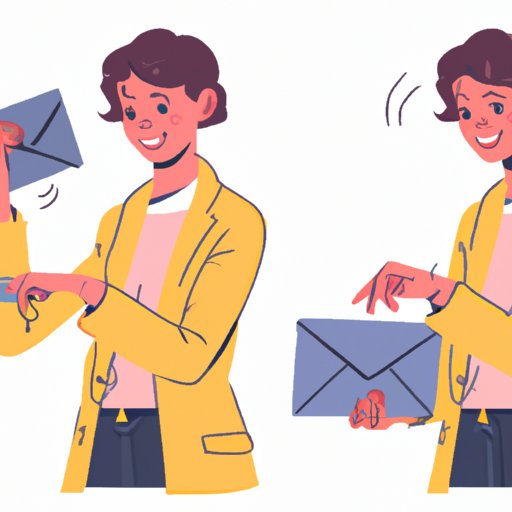
I. Introduction
Email communication plays a vital role in our personal and professional lives. Yet, not everyone knows how to write an effective email that reflects their level of professionalism. Whether you’re sending an email to a colleague, client, or potential employer, it’s important to craft a message that is clear, concise, and appropriate. In this article, we’ll cover the dos and don’ts of email writing, basic email etiquette, and tips for maximizing the impact of your email communication.
II. 5 Simple Tips to Write a Professional Email That Gets Noticed
To create an effective email that gets noticed, follow these simple tips:
Tip 1: Keep it concise
Avoid unnecessary details or rambling sentences that can detract from your message. Use short paragraphs and bullet points to make your message clear and easy to read.
Tip 2: Use a proper greeting and sign off
Using a proper greeting and sign off can set the tone for your email and demonstrate your level of professionalism. Use “Dear” followed by their name to begin, and end with a proper sign off such as “Sincerely” or “Best regards”.
Tip 3: Be clear and specific in your subject line
Your subject line should reflect the content of your email. It should be concise, specific, and informative. Avoid using vague or misleading subject lines to prevent confusion or misinterpretation.
Tip 4: Proofread your email before hitting send
Sloppy errors in your email can undermine your credibility and professionalism. Make sure to read your email carefully and double-check grammar, spelling, and punctuation errors. Use professional language and avoid colloquialisms or slang.
Tip 5: Follow up if necessary
If your email requires a response or a follow-up action, make sure to include a specific request or deadline. If you do not receive a response in a timely manner, it’s appropriate to send a polite follow-up email as a reminder.
III. Mastering the Art of Email Communication: A Beginner’s Guide
Effective email communication requires basic etiquette and appropriate tone and language. To master the art of email communication, follow these guidelines:
Overview of basic email etiquette
Basic email etiquette includes appropriate salutations and sign-offs, using formal titles when appropriate, avoiding slang or informal expressions, and using a professional email address. Keep in mind the level of formality required by the recipient and the nature of the relationship.
Importance of proper tone and language
The tone and language of your email should be appropriate for the recipient and reflect your level of professionalism. Avoid using humor, sarcasm, or language that can be construed as arrogant or confrontational. Use specific and informative language that is respectful and courteous.
Examples of effective email communication
Effective email communication can help to build professional relationships, establish rapport, and achieve your goals. Here are some examples of effective email communication:
- A follow-up email after a job interview
- An email to introduce yourself to a new client or colleague
- An email to request a meeting or information
- An email to express gratitude or appreciation
IV. The Dos and Don’ts of Writing an Effective Email
To create an effective email, follow these dos and don’ts:
Dos:
- Use a professional tone
- Personalize your message
- Include all necessary details
- Ensure clarity in your message
- Address the recipient by name
Don’ts:
- Use slang or informal language
- Send unclear messages
- Ignore proper grammar and spelling
- Use overbearing or threatening language
- Include irrelevant information
V. Maximizing the Impact of Your Email – A Step-by-step Guide
To maximize the impact of your email, follow these steps:
Step 1: Identify your purpose and audience
Before writing your email, identify the purpose and audience. Decide what you want to communicate, who you’re communicating with, and the level of formality required.
Step 2: Craft a compelling subject line
Your subject line is the first thing your recipient will see. It should be compelling, specific, and informative. Avoid using gimmicky or misleading subject lines.
Step 3: Write a clear and concise message
Your message should be clear, concise, and easy to read. Use short paragraphs, bullet points, and proper email formatting to make your message more visually appealing and accessible.
Step 4: Edit and proofread your email
Edit and proofread your email to ensure that it is free from grammar, spelling, and punctuation errors. Use professional language and avoid colloquialisms or slang.
Step 5: Follow up if necessary
If you do not receive a timely response to your email, it’s appropriate to send a polite follow-up email as a reminder. Make sure to include a specific request or deadline in your follow-up email.
VI. Crafting the Perfect Email Message – Expert Advice from Seasoned Professionals
Expert advice from seasoned professionals can provide additional insights and tips on crafting effective emails. Here are some examples of successful email communication in various industries:
Interviews with professionals to provide additional tips and advice on crafting effective emails
- A marketing professional who has experience with email campaigns
- A human resources professional who has experience with emails to potential candidates
- A sales professional who has experience with emails to potential clients
Examples of successful email communication in various industries
- An email from a real estate agent to a client
- An email from a teacher to a parent
- An email from a social media manager to a client
VII. Conclusion
Writing a professional email requires basic etiquette, appropriate tone and language, and attention to detail. By following the tips and strategies outlined in this article, you can create an email that gets noticed and achieves your desired goals. Remember to identify your purpose and audience, use a compelling subject line, and follow up if necessary. With practice and patience, you can master the art of email communication and build successful professional relationships.




